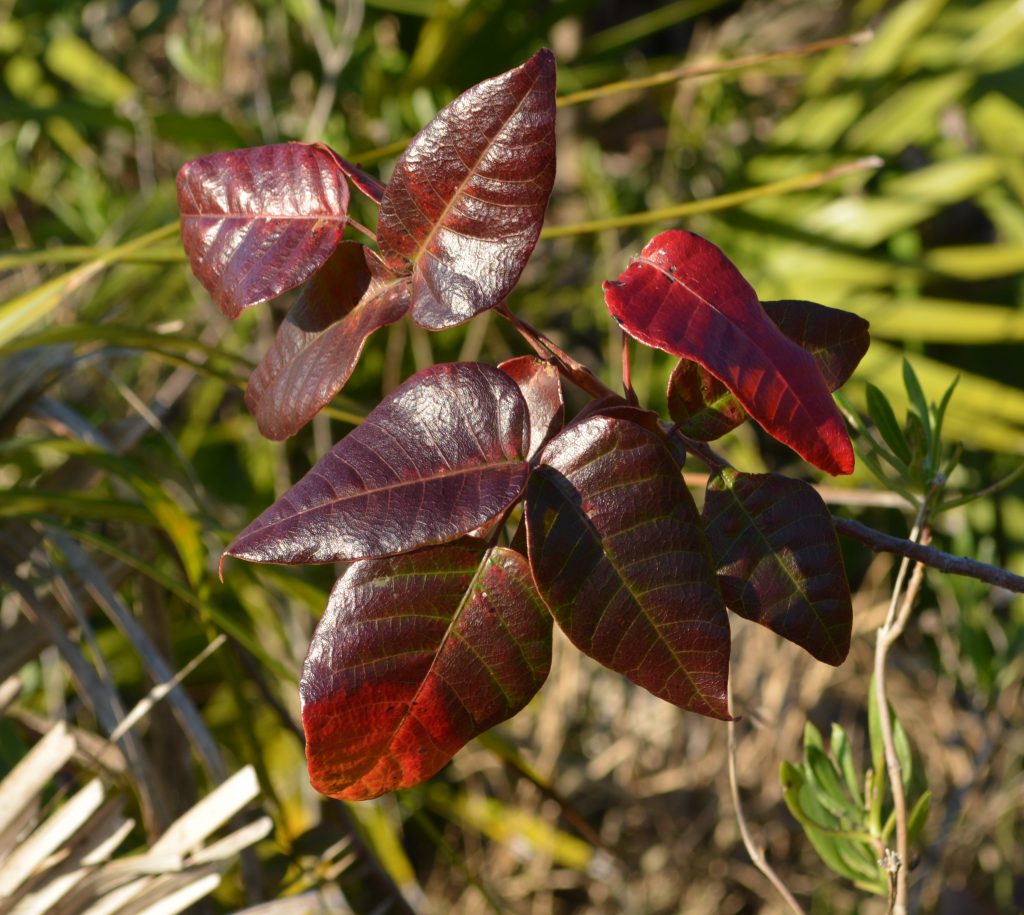
Fall poison ivy at Ft. Desoto, Fl. Photo by Green Deane

North Carolina herbalist Will Endres
His name was Will Endres and he was a North Carolina Herbalist who unfortunately died earlier this year. I remember him for two reasons. About 20 years ago he came to central Florida and wanted to see some local plants. I showed him around. He suggested I teach foraging classes, which I was very reluctant to do as I am the introvert’s introvert. The rest, as they say, is history. The other thing I leaned from him was that he ate poison ivy every spring.

Forager Euell Gibbons was also a boxer.
That’s controversial to say the least. He was not alone. The famous forager of the last century, Euell Gibbons, left, reported he ate it every spring and I met a women in north central Florida who ate it though ”met” is the wrong verb. In fact, I was having a class near Deland. We were walking along and I said “there’s some poison ivy.” Then I heard a little voice behind me say “oh, goody, I haven’t had any yet this year.” I turned in time to see her eating poison ivy… I don’t recommend it.
They are not alone. The Pennsylvania Dutch (the German amish) regularly wrapped poison ivy leaves in bread and ate it. The thinking is it’s protective though I am not aware of any research on the topic. I would think it would be difficult to get volunteers. Now they are researching a vaccine for poison ivy though I imagine it would be to moderate the body’s response to it rather than reduce its method of action.
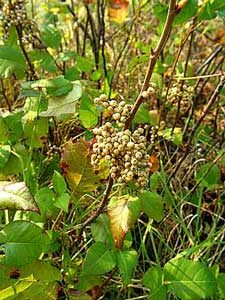
Poison Ivy berries are also toxic. Photo by Green Deane
Poison Ivy is a complex of several oils. The plant cells have to be broken for it to release them. It may be that folks who swear by eating it do so in the early spring when the plant might not have much oil. The oil, called urushiol, is actually omega 6 fatty acids. When they touch live skin cells they cause the proteins in the cells to get sticky. That interrupts the body’s communication to the cells signaling the body to get rid of them (which makes one wonder why they couldn’t deliver urushiol to cancer cells. Native Americans used poison ivy to get rid of warts.) There is some speculation that omega 6 oils in other plants do the same thing to our gut lining producing things like Irritate Bowel Syndrome. Very few creatures get poison ivy; Humans, certain primates, and guinea pigs. Those three also don’t make their own vitamin C. When poison ivy oil dries it become inert and is the shiny coating on Japanese utensils. Urushiol means shelack. All that said the University of Mississippi is going forward with a poison ivy vaccine. It would require yearly injections or every other year.
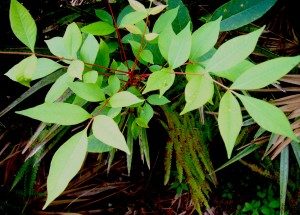
Poison Sumac, note the red stems with stronger than poison ivy. Photo by Green Deane
Current thinking is you are born with a certain amount of resistance to poison ivy and each exposure reduces your resistance. At some point nearly everyone will get it. About every six weeks I hear from someone who thought they were immune and had been removing it annually from their yard for years. Those are the folks who end up in the hospital with a severe case of it. Researchers at the university think shots will “lead to desensitization and reduce or eliminate reactions to poison ivy, oak and sumac.” About one-sixth of all Americans get poison ivy every year, some 50 million people annually. Eighty-five percent of the population is definitely allergic to it and up to 15% very allergic. It grows everywhere in North America except Alaska and some Nevada deserts. There’s none in Hawaii. The oil is not contagious but can last for years on clothes or even short term on farm animals and pets. I once got poison ivy from the feathers of a mallard duck.
If affected with poison ivy the CDC says people should seek medical attention if they have a temperature over 100 degrees Fahrenheit, there is pus or soft yellow scabs on the rash, the itching gets worse, they have difficulty breathing and the rash spreads to eyes, mouth, genital area or more than one-fourth of the skin. A high school friend of mine at a summer camp went petting with a lass in a poison ivy patch…. they had poison ivy in places one does not want to ponder. The vaccine is going into clinical trials.
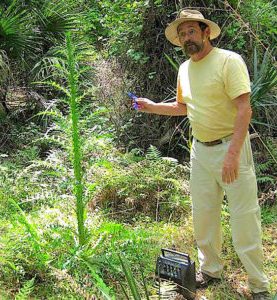
Foraging classes are held rain or shine, heat or cold. Photo by Nermina Krenata
Foraging Classes: Sticking to the eastern part of the state this weekend, east Orlando and just north of Jacksonville. There shouldn’t be any hurricanes this weekend.
Saturday September 25th, Blanchard Park, 10501 Jay Blanchard Trail, Orlando, FL 32817. 9 a.m. to noon, meet by the tennis courts.
Sunday September 26th, Tide Views Preserve, 1 Begonia Street, Atlantic Beach Fl 32233 (near Jacksonville Fl.) 9 a.m. to noon. Meet in the only parking lot.
Saturday October 2nd, Eagle Park Lake, 1800 Keene Road, Largo, FL 33771. 9 a.m. to noon, meet at the pavilion near the dog park.
Sunday October 3rd, Boulware Springs Park, 3420 SE 15th St., Gainesville, FL 32641. Meet at the picnic tables next to the pump house. 9 a.m. to noon.
Saturday October 9th, Honea Path, South Carolina, classes at 9 a.m. and 1 p.m. each day. 1624 Taylor Road Honea Path, SC 29654.
Sunday October 10th, Honea Path, South Carolina, classes at 9 a.m. and 1 p.m. each day. 1624 Taylor Road Honea Path, SC 29654.
For more information, to pre-pay or sign up go here.
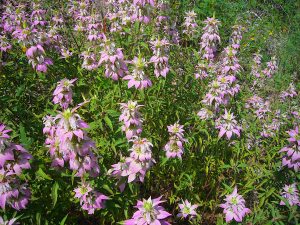
Horsemint (Monarda punctata) will be easy to find for several weeks. Photo by Green Deane
We’ve mentioned it a few times in recent newsletters but it bares repeating one more time: Horsemint — left — is in season and very easy to find now. Look in grassy sandy places or along paths in always dry areas. The pleasant side of the plant is that it smells nice and makes a Thyme-like spice. The naughty side of the species is that it contains Thymol which is a relaxant. Made into a tea it calms you down. How much it calms you down depends on how much you use and your personal response to it. You can also hang some in your house as an air freshener. You can read about Horsemint here.
Our timing Saturday was near perfect. The husks of the Coastal Ground Cherry were gold, dry and papery. Inside the fruit was deep yellow to gold, tangy in taste. Ground cherries, in this case Physalis angustifolia, ripen from green to gold, getting sweeter and tangier as they go along. But they can often have a bitter aftertaste either from being under ripe or some species just retain some bitterness. A little aftertaste of bitterness is okay but the best is when there is none. Thus one always tastes a ripe ground cherry then waits a minute or so for any bitterness to appear.
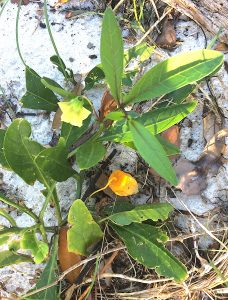
As the Ground Cherry ripens the husk turns golden. Photo by Green Deane
While locally Ground Cherries can fruit nearly all year, they do produce a spring and fall crop. In cooler climes they just have one season ripening in late summer and fall. Here our fall crop tends to be better than our spring one. Spring ground cherries can rot on the plant or get damaged by insects and that is also when I tend to find more bitter ones. But this time of year brings out the best in ground cherries. One can find whole, undamaged, very ripe Ground Cherries in significant numbers. You can make a pie out of them if you can manage to get some home uneaten. Incidentally there is a second local ground cherry that resembles the Coastal Ground Cherry. It’s Physalis walteri, also known as starry-hair ground-cherry and sand cherry. It has star-shaped hairs on the lower edges of the leaf which are visible with a hand lens. Still edible, however. To read more about Ground Cherries go here.

Green Deane videos are now available on a USB.
My nine-DVD set of 135 videos has been phased out and replaced by a 150-video USB. The USB videos are the same videos I have on You Tube. Some people like to have their own copy. The USB videos have to be copied to your computer to play. If you want to order the USB go to the DVD/USB order button on the top right of this page or click here. That will take you to an order form. I’d like to thank all of you who ordered the DVD set over the years which required me to burn over 5,000 DVDs individually.

Green Deane Forum
Want to identify a plant? Perhaps you’re looking for a foraging reference? You might have a UFO, an Unidentified Flowering Object, you want identified. On the Green Deane Forum we — including Green Deane and others from around the world — chat about foraging all year. And it’s not just about warm-weather plants or just North American flora. Many nations share common weeds so there’s a lot to talk. There’s also more than weeds. The reference section has information for foraging around the world. There are also articles on food preservation, and forgotten skills from making bows to fermenting food.
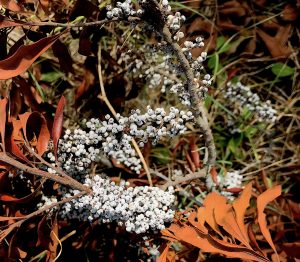
Southern Wax Myrtle berries. Photo by Green Deane
Humans often see beauty in dead plants from bouquets to Christmas wreaths. A woods road’s trimming in offered us an unusual view of Southern Wax Myrtle berries. Light gray they often hide in the green aromatic leaves of this shrub. However when the trimmed leaves browned it revealed the concealed berries. They can be used as a spice when dried and put in a pepper mill. And if you have a lot of them (and the need) they also produce a green wax. If you mix that wax with one quarter tallow it makes a smokeless candle that keeps away biting insects. That chandle, however, is a lot of work. But, if it is all you have to drive away insects it’s much worth it.
This is weekly newsletter #475, If you want to subscribe to this free newsletter you can find the sign-up form in the menu at the top of the page.
To donate to the Green Deane Newsletter click here.


Would love some wax Myrtle seeds. We have two, but they don’t produce the berries.